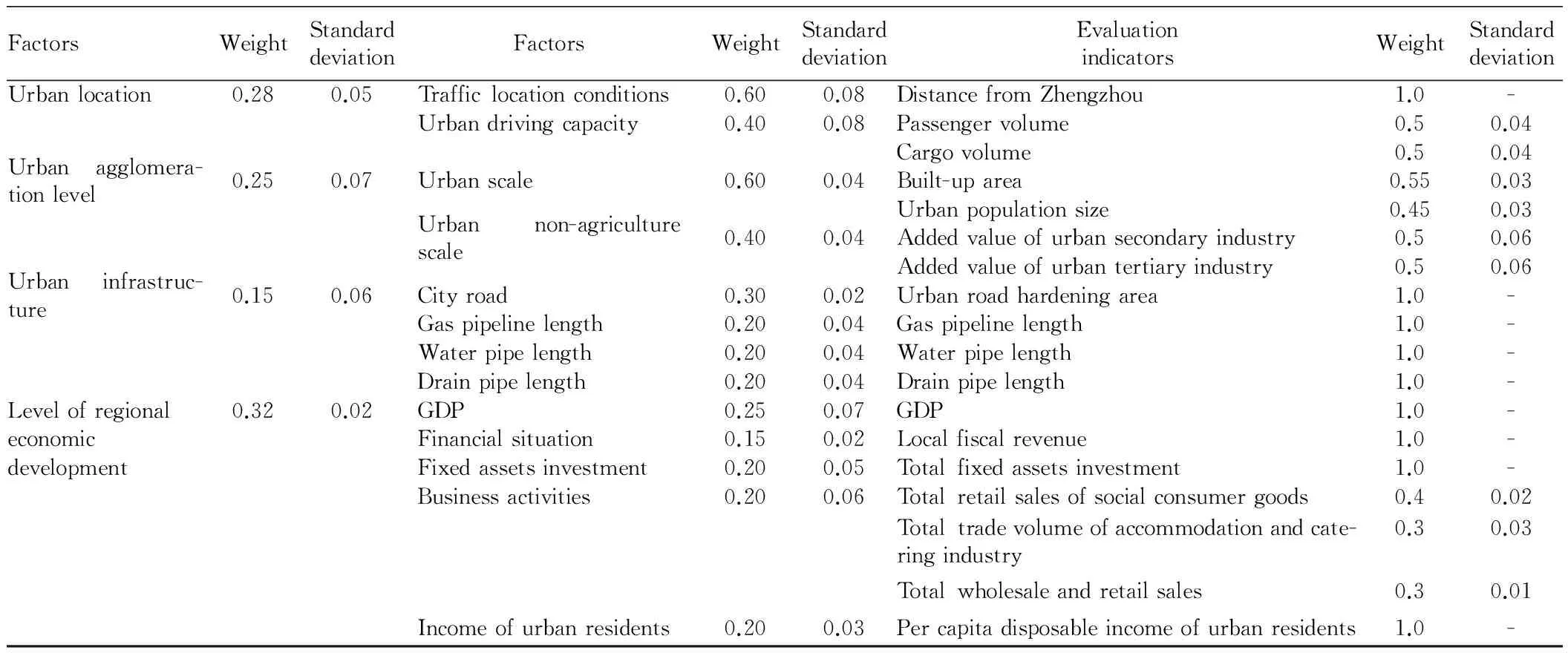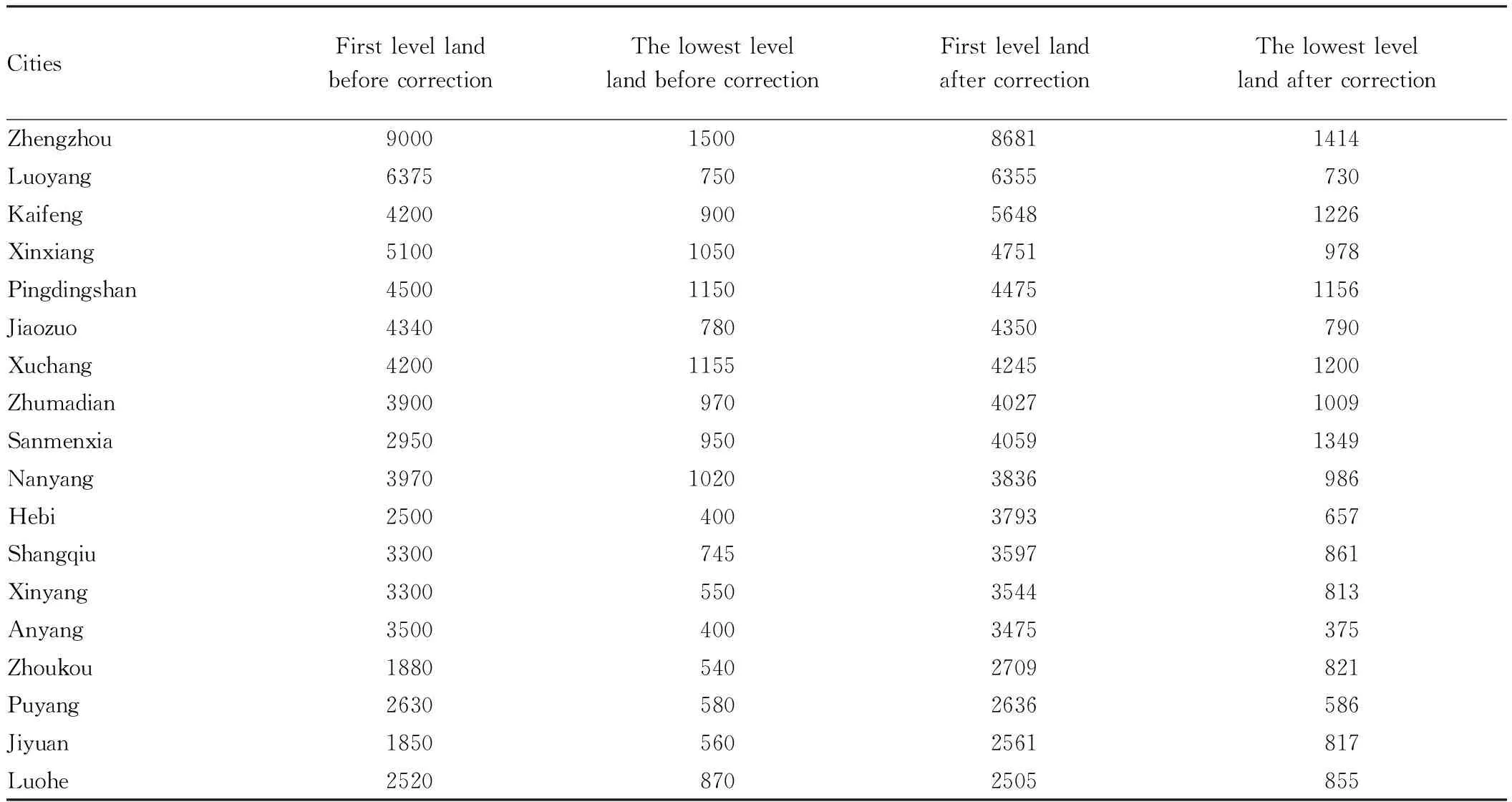A Study on the Standard Land Price Balance of Urban Commercial Land in Henan Province
2016-01-12
Institute of Geographical Sciences, Henan Academy of Sciences, Zhengzhou 450052, China
1 Introduction
Henan (31°23′-36°22′N, 110°21′-116°39′E) is a province of the People’s Republic of China, located in the central part of the country, and approximately a quarter of the province lies north of the Yellow River. With an area of 167000 km2, Henan covers a large part of the fertile and densely populated North China Plain. Its neighboring provinces are Shaanxi, Shanxi, Hebei, Shandong, Anhui, and Hubei. Henan has a diverse landscape with floodplains in the east and mountains in the west, and it stretches across Haihe River, Yellow River, Huaihe River and Yangtze River. Henan has a warm temperate-subtropical, humid-semi-humid monsoon climate. At the end of 2013, it had a total population of 106.01 million. The object of balance study is the urban commercial land price in 18 cities (Zhengzhou, Kaifeng, Luoyang, Pingdingshan, Anyang, Hebi, Xinxiang, Jiaozuo, Puyang, Xuchang, Luohe, Sanmenxia, Nanyang, Shangqiu, Xinyang, Zhoukou, Zhumadian, and Jiyuan) of Henan Province.
2 Technology roadmap of balance
(i) In accordance with the requirements of Urban Land Classification Standards, the urban land quality of various cities is graded, and the grading index is regarded as the basic control basis to determine the order of various cities. (ii) In accordance with the actual situation of Henan Province, the unified setting of land price connotation is conducted on the level of land price in various cities, the level of land price is amended accordingly, and the expression form of land price is unified. (iii) The economic and social indicators affecting urban land quality are selected to grade the cities, and based on the indicator weight, the grading index of various cities is calculated. (iv) Based on the above grading index and the minimum and maximum land price level corrected in various cities, the grading index and the corresponding interval of land price value are determined, and the price level in various cities is sequenced according to the index. (v) According to the characteristics of different land types, the corresponding indicators are selected, and the control value of balanced urban land price is corrected based on balance index, to get the preliminary results of land price balance. (vi) The preliminary results are fed back to each city, demonstrated by the relevant experts organized by Municipal Bureau of Land and Resources, and demonstrated by the relevant experts organized by Provincial Department of Land and Resources. (vii) Based on the opinions of provincial and municipal experts, according to the actual price level in various cities, the final balance results of urban standard land price in various cities are determined.
3 Standard land price balance
3.1ConnotationofbalanceTo balance the level of standard land price in various cities, we set the connotation of land price balance: the average price of complete land use rights for the same land use type, under a certain degree of development, a certain degree of land volume ratio, the highest transfer period and a valuation reference date, based on various types of urban construction land and various levels of land. (i) Degree of land development. According to the current status of each city and land use classification, the degree of development includes supply of traffic, electricity, water, communication, drainage, gas and heating, and land leveling. (ii) Land volume ratio. Commercial land (2.5); residential land (2.5); land for industry, mining and warehousing (1); transport land (1); water conservancy facility land (1); special land (1); public management and public service land (1.5). (iii) Land usage term. Commercial land (40 years); residential land (70 years); land for industry, mining and warehousing (50 years); transport land (50 years); water conservancy facility land (50 years); special land (50 years); public management and public service land (50 years); tourism and recreational land (40 years). (iv) Valuation reference date. The valuation reference date for the standard land price is January 1, 2013.
3.2Balanceindicatorsystemandweight
3.2.1Selection principles of indicators. (i) The index value change of land balance factors has a significant impact on the standard land price, and can directly and objectively reflect the quality of land with standard price in the balance areas. (ii) The index value of land balance factors has a wide range of variation. (iii) There is a large difference in the impact of the selected factors on different regions, and the index can reflect the difference in standard land price between different regions. (iv) The land balance factors reflect the current land use, and have influence on future regional land use. (v) The land balance factors are easy to be obtained via statistics or quantified.
3.2.2Indicator system building and weighting. According to the above principles and the actual situation of the province, the classic Delphi method is used, and 25 experts in the departments of land, planning, statistics, business and transportation are invited, to select various levels of balance factors. After two rounds of consultation and scoring, the weight of various land balance factors is determined. There is a grading standard land price among the 18 cities, and in terms of landscape, scale and transportation, there is also a large difference in the lowest level land among the cities, so the lowest level land has an independent indicator system when building the indicator system. The balance indicators for standard price of first level and penultimate level land in Henan Province and the corresponding weight can be shown in Table 1. The balance indicators for standard price of the lowest level land and the corresponding weight can be shown in Table 2. According to balance index results, there are five classes of cities. Class I city (Zhengzhou); Class II city (Luoyang, Xinxiang, Kaifeng); Class III city (Xuchang, Luohe, Jiaozuo, Pingdingshan, Anyang); Class IV city (Hebi, Jiyuan, Nanyang, Puyang, Shangqiu); Class V city (Zhumadian, Zhoukou, Xinyang, Sanmenxia).
Table1Thebalanceindicatorsandweightconcerningfirstlevelandpenultimatelevelcommerciallandinvariouscities

FactorsWeightStandarddeviationFactorsWeightStandarddeviationEvaluationindicatorsWeightStandarddeviationUrbanlocation0.280.05Trafficlocationconditions0.600.08DistancefromZhengzhou1.0-Urbandrivingcapacity0.400.08Passengervolume0.50.04Cargovolume0.50.04Urbanagglomera-tionlevel0.250.07Urbanscale0.600.04Built-uparea0.550.03Urbanpopulationsize0.450.03Urbannon-agriculturescale0.400.04Addedvalueofurbansecondaryindustry0.50.06Addedvalueofurbantertiaryindustry0.50.06Urbaninfrastruc-ture0.150.06Cityroad0.300.02Urbanroadhardeningarea1.0-Gaspipelinelength0.200.04Gaspipelinelength1.0-Waterpipelength0.200.04Waterpipelength1.0-Drainpipelength0.200.04Drainpipelength1.0-Levelofregional0.320.02GDP0.250.07GDP1.0-economicFinancialsituation0.150.02Localfiscalrevenue1.0-developmentFixedassetsinvestment0.200.05Totalfixedassetsinvestment1.0-Businessactivities0.200.06Totalretailsalesofsocialconsumergoods0.40.02Totaltradevolumeofaccommodationandcate-ringindustry0.30.03Totalwholesaleandretailsales0.30.01Incomeofurbanresidents0.200.03Percapitadisposableincomeofurbanresidents1.0-
Table2Thebalanceindicatorsforstandardpriceofthelowestlevellandandthecorrespondingweight

FactorsWeightStandarddeviationFactorsFactorexplanationWeightStandarddeviationGeographicconditions0.200.04TrafficconditionsTheaveragedistancebetweenthelowestlev-ellandandtheneighboringurbancenter1.00-Levelofeconomicdevelop-ment0.450.06GDPGDP0.200.04FinancialsituationFinancialsituation0.150.03FixedassetsinvestmentFixedassetsinvestment0.200.02IncomeofurbanresidentsIncomeofurbanresidents0.150.05UrbanscaleRatiooflong-termplanningareatogradingarea0.300.03Landformtype0.350.05RegionallandformtypeLandformtypeofthelowestlevelland1.00-
3.2.3The corrected price after unification of standard land price connotation. Through the above analysis, the corrected price after unification of standard commercial land price connotation in 18 cities of Henan Province in 2013 is shown in Table 3.
4 Balance results
4.1RelationsbetweenlandpriceandurbanhierarchyIn general, the higher the level of the city, the higher the standard price for the same level of land. In terms of one city, since the commercial land generally occupies the relatively prosperous area, its standard price is generally higher than that of the land for industry and warehouse, while the standard price of residential land is generally higher than that of the land for industry and warehouse. The standard urban land price balance results in various cities of Henan Province are also consistent with this law. In addition, with the decreasing level of cities, the price of the land at the same level shows a decreasing trend. For the 18 cities, the levels of land are most in Class I city, followed by Class II city, and the levels of land are least in Class V city. Generally, if a city has high level of development and large built-up area, the regional differences will be remarkable, the level of land price will be greatly different, and there will be many levels of land. However, according to the actual needs, the land may be divided into many levels in the lower level city.
Table3Standardpricecorrectionofcommerciallandin2013Unit: yuan/m2

CitiesFirstlevellandbeforecorrectionThelowestlevellandbeforecorrectionFirstlevellandaftercorrectionThelowestlevellandaftercorrectionZhengzhou9000150086811414Luoyang63757506355730Kaifeng420090056481226Xinxiang510010504751978Pingdingshan4500115044751156Jiaozuo43407804350790Xuchang4200115542451200Zhumadian390097040271009Sanmenxia295095040591349Nanyang397010203836986Hebi25004003793657Shangqiu33007453597861Xinyang33005503544813Anyang35004003475375Zhoukou18805402709821Puyang26305802636586Jiyuan18505602561817Luohe25208702505855
4.2CommerciallandpricedistributionindifferentcitiesofHenanProvince
4.2.1The level of land price is basically consistent with the economic level. By analyzing the standard land price in the 18 cities, based on different types of land, the land price is divided into 3-5 levels. Broadly speaking, Zhengzhou has the highest level of urban land price, followed by Luoyang and Kaifeng, and Jiyuan, Zhoukou, Hebi and Shangqiu have a low level of urban land price. Apart from a handful of cities, the level of land price is basically consistent with the economic level in various cities.
4.2.2The land price is affected by local policies. The level of urban commercial land price is not only affected by the economic level, but also affected by the local land price policies. For several cities, the level of economic development is above average in the province, but its commercial and residential land price level is below average, which may be related to the impact of local land price policies.
4.2.3The commercial land price shows obvious regional distribution characteristics.The level of commercial land price shows an obvious decreasing trend from the center of Zhengzhou to the periphery. Luoyang, Kaifeng, Jiaozuo, Xinxiang, Xuchang and Pingdingshan are in the Central Plains Urban Agglomeration with Zhengzhou as the center, so the overall price of land is high. Zh-engzhou, Kaifeng, Luoyang, Sanmenxia, Xinxiang, Xuchang, Zhumadian and Xinyang are along the high-speed rail line, so the level of land price is high. The increase in location advantages is one of the reasons for a substantial increase in urban land price in some cities distant from Zhengzhou, such as Sanmenxia, Zhumadian and Xinyang. Overall, the level of land price shows a decreasing trend from the center of Zhengzhou to the surrounding cities.
4.2.4There is a large difference in the level of commercial land. In the same city, there is a large difference in the price of commercial and residential land in prosperous areas. In Zhengzhou City, the highest level of commercial land price is 8681 yuan/m2(revised price), followed by Luoyang City with the highest price of 6355 yuan/m2and the lowest price of 2500 yuan/m2.
[1] YANG XX, ZHU QW. Study on balance of benchmark land prices among region cities[J]. Resource Development & Market,2007,23(9):799-801.(in Chinese).
[2] ZHANG B, LIU JC, ZHANG JF. Study on the balance of datum land price among cities[J]. China Land,2006(7):19-22.(in Chinese).
[3] LI N. A brief analysis on balance of benchmark land prices among region cities and its trend[J]. New Western,2011(18):91-92.(in Chinese).
[4] HUA W, FAN L, WU Q,etal. Regression analysis of urban land value influencing factors: for Jiangsu Province[J]. Economic Geography,2005, 25(2):203-205, 218.(in Chinese).
杂志排行
Asian Agricultural Research的其它文章
- Economic Analysis on the Rational Allocation of Agricultural Production Factors in Henan Province
- Special Space and Plant Landscape Design of Urban Ecological Buildings
- Main Methods Applied in Fertigation Technology
- A Study on the Ultrasonic Extraction and Antioxidant Activity of Lychee Pericarp Polysaccharides
- The Fishery Industrial Structure in China Based on the Application of Shift-Share Analysis
- Spatial Structure of Tourism Resources in Liaoning Province
